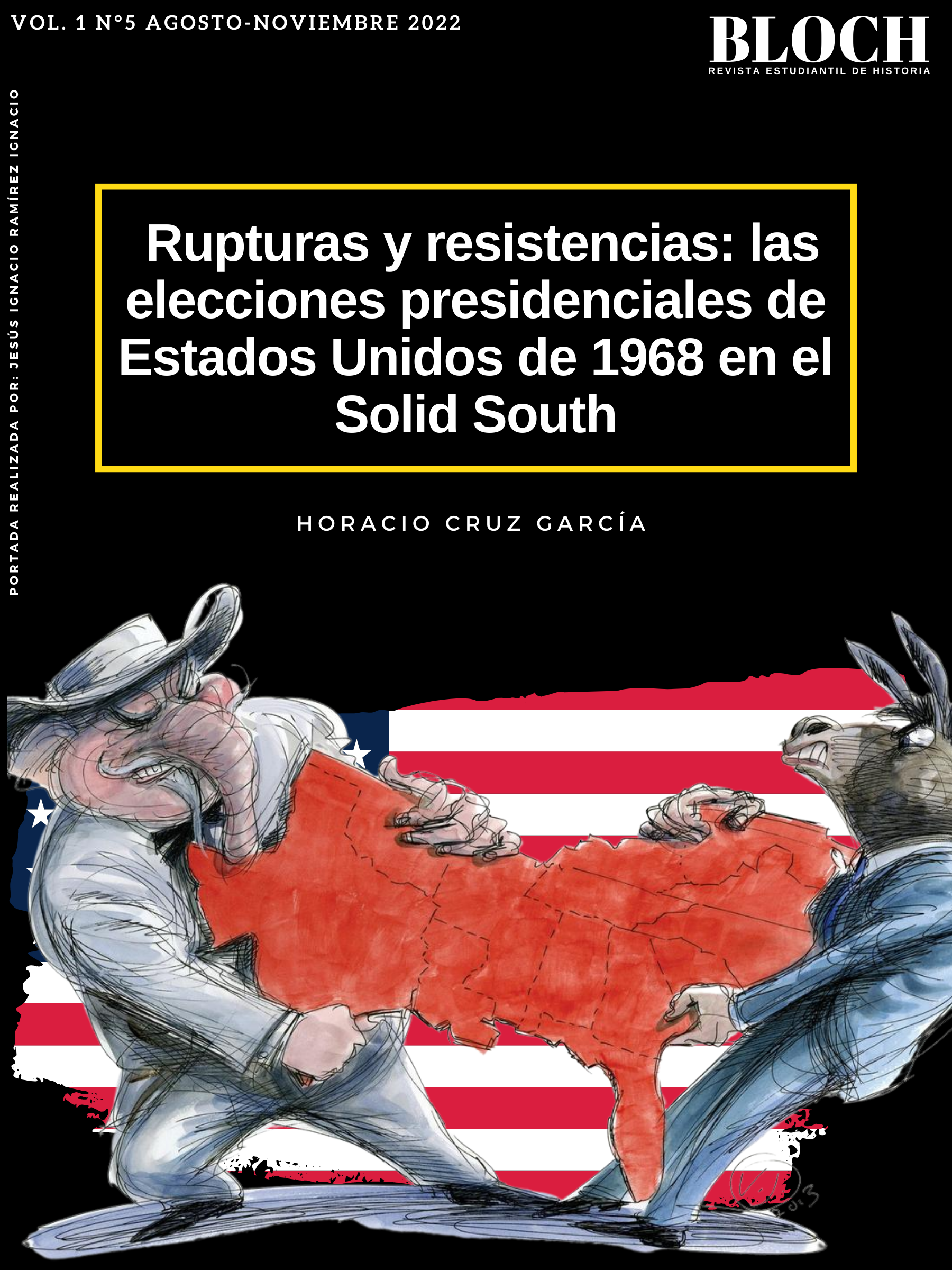Breaks and resistances: the 1968 United States presidential elections in the Solid South

Published 2022-11-13
Keywords
- Solid South; civil rights; United States; racism; George Wallace.
How to Cite
Copyright (c) 2022 Horacio Cruz García

This work is licensed under a Creative Commons Attribution 4.0 International License.
Abstract
This article studies the United States presidential election in 1968, in a particular region named Solid South, characterized by the almost centenary-old dominance of the Democratic Party, as well as by prevailing racism and segregation. This election was quite peculiar due to the presence of a third candidate with a populist and racist rhetoric, who attracted a significant amount of the popular voting and was an exception within the bi-partisan dynamic between Democrats and Republicans. On the other hand, the electoral process was held in the midst of a convulsive decade, with the effervescence of social and civil rights movements. This text begins with a general presentation of the Solid South, examines the social and civil rights movements in United States and the development of the 1968 elections, as well as their results in that region. Finally, it addresses the political-partisan consequences of that election and concludes with a brief summary.
Downloads
References
- Ángel Israel Rivera Ortiz, “Las elecciones estadounidenses de 2020: polarización y democracia”, Tempo Exterior XX (II), no. 41 (2020), 106, 113-114.
- Dewey W. Grantham, The life and death of Solid South. A political history (Lexington, KE: The University Press of Kentucky, 1992), XI-XII.
- Hilary A. Herbert, ed., Why the Solid South? Or Reconstruction and its Results (Baltimore: R. H. Woodward & Company, 1890), V-XIII.
- Allan Nevins, Henry S. Commager y Jeffrey Morris, Breve historia de los Estados Unidos, trad. Francisco González Aramburo (México, Fondo de Cultura Económica, 1994), 231-233.
- Herbert, Why the Solid South?, 430.
- Nevins, Commager y Morris, Breve historia, 233-235.
- Earl Black y Mearl Black, The Rise of Southern Republicans (Cambridge, MA: Harvard University Press, 2002), 3.
- Alan Brinkley, Historia de los Estados Unidos. Un país en formación, 3ª ed., trad. Carlos Julio Briceño (México, McGrawl-Hill Interamericana Editores, 2011), 857-862.
- Brinkley, Historia de los Estados Unidos, 862-863.
- Office of the Historian, “The Civil Rights Movement And The Second Reconstruction, 1945-1968”, en History, Art & Archives, U.S. House of Representatives,consultado el 18 de enero de 2022, https://history.house.gov/Exhibitions-and-Publications/BAIC/Historical-Essays/Keeping-the-Faith/Civil-Rights-Movement/.
- Brinkley, Historia de los Estados Unidos, 863-865.
- Office of the Historian, “The Civil Rights Movement”.
- Nevins, Commager y Morris, Breve historia, 545-547.
- Josep Fontana, El siglo de la revolución. Una historia del mundo desde 1914 (Barcelona: Crítica, 2017), 349
- Brinkley, Historia de los Estados Unidos, 868-869.
- Nevins, Commager y Morris, Breve historia, 568-569.
- “Strom Thurmond, a featured biography”, en United States Senate ,consultado el 13 de junio de 2022, https://www.senate.gov/senators/FeaturedBios/Featured_Bio_Thurmond.htm; Office of the Historian, “The Civil Rights Movement”.
- Roberta Walburn, Miles Lord: The Maverick Judge who brought Corporate America to Justice (Minneapolis, London: University of Minnesota Press, 2014), 190-194.
- Joseph E. Lowndes, From the New Deal to the New Right: Race and Southern Origins of Modern Conservatism (New Haven: Yale University Press, 2008), 78-79, 82-83.
- Lowndes, From the New Deal, 93-99.
- Lowndes, From the New Deal, 107, 116.
- Lowndes, From the New Deal, 119.
- Brinkley, Historia de los Estados Unidos, 884.
- George B. Tindall, “Southern Strategy: a historical perspective”, The North Carolina Historical Review 48, no. 2 (1971), 129-132.
- Black y Black, The Rise of Southern Republicans, 3.
- Grantham, The life and death, 178-181.
- Black y Black, The Rise of Southern Republicans, 4.
- Lowndes, From the New Deal, 120.
